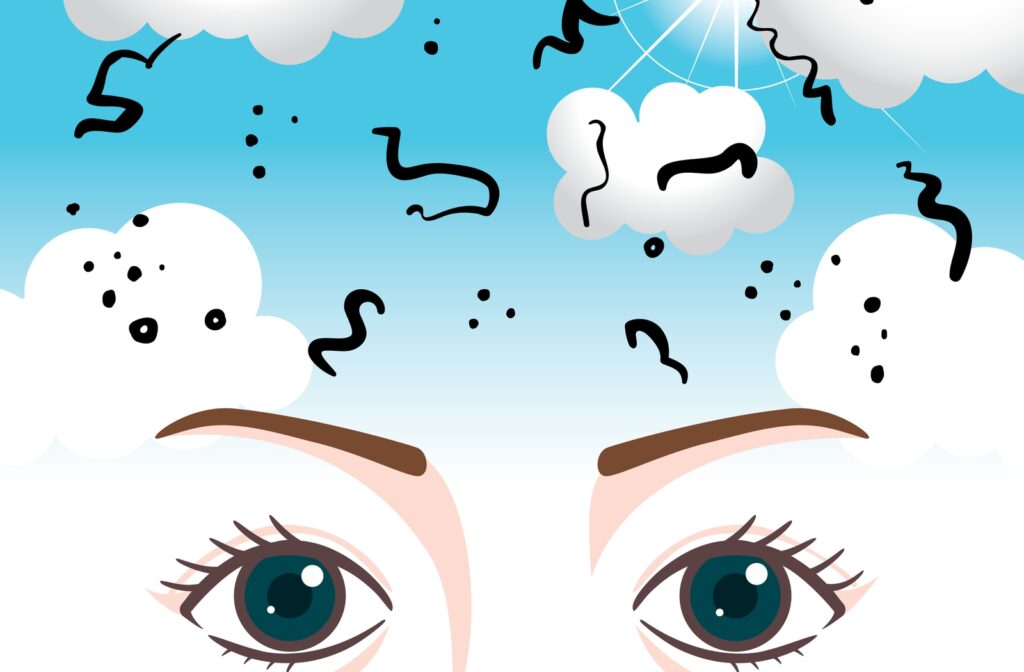Eye Health Effects: Dry Eye & Floaters
From blurry vision to bloodshot eyes, dry eye is a common eye condition, causing multiple symptoms. It’s not always a pretty sight, and it can be even more unsettling if you also spot floaters.
Visiting Eye Lab for an eye exam can help you understand your vision and develop a plan for managing symptoms. For example, when dry eyes are the cause, we can recommend treatment through dry eye therapy.
But suppose dry eyes aren’t your only concern. In that case, we can evaluate your eye health to learn more about what’s causing strange visual effects, including floaters.
Floaters are shapes that appear in your vision, commonly taking the form of spots, cobwebs, or squiggly lines. It can seem like the object is in front of your vision, but it’s inside your eye.
You may experience dry eyes and floaters at the same time, but dry eyes alone do not cause floaters. Although not directly connected, dry eyes and floaters share many common risk factors.
Some shared causes include:
Eyes & Floaters
Experiencing any vision changes can be uncomfortable, but dry eyes are particularly irritating. Unfortunately, dry eye is a common condition, causing multiple symptoms, from blurry vision to bloodshot eyes. It’s not always a pretty sight, and it can be even more unsettling if you also spot floaters.
Visiting Eye Lab for an eye exam can help you understand your vision and eye health. We can help develop a plan for managing symptoms. For example, when dry eyes are the cause, we can recommend treatment through dry eye therapy.
But suppose dry eyes aren’t your only concern. In that case, we can evaluate your eye health to learn more about what’s causing strange visual effects, including floaters.
What Are Floaters?
Floaters are shapes that appear in your vision, commonly taking the form of spots, cobwebs, or squiggly lines. It can seem like the object is in front of your vision, but it’s inside your eye.
Floaters move with your eye. So when you try to look at the strange object, you can’t focus on it. After eye movement, you may experience a floater moving across your vision.
Floaters are tiny clumps of cells located in the vitreous layer of your eyes. Instead of seeing the clumps, what you’re seeing is their shadow cast over the retina. The retina collects light, translating it into electrical signals. Then, the signals to the brain through the optic nerve, which our brain understands as vision.
Typically, vitreous humor is a transparent, gel-like substance, allowing light to travel through easily. However, the vitreous contains proteins, which can get trapped if formed at birth or result from vitreous fluid deterioration.
Are Floaters and Dry Eyes Connected?
Dry eyes can impact your vision and eye health in many ways. You may even experience dry eyes and floaters at the same time.
But dry eyes alone do not cause floaters.
Both conditions are typically harmless long-term but can cause permanent damage when caused by other eye conditions.
Advanced dry eye can damage the front surface of the eye, but typical symptoms include:
- Dry eyes
- Redness
- Watery eyes
- Burning or stinging sensation
- Light sensitivity
- Stringy mucus
- Blurry vision
What Causes Dry Eyes and Floaters?
Although not directly connected, dry eyes and floaters share many common risk factors. There are 2 common risk factors that can cause both conditions simultaneously: aging and eye injuries.
Aging
Aging changes our eyes and increases the risks of many eye conditions, including cataracts, glaucoma, age-related macular degeneration (AMD), retinal detachment, and dry eyes.
Nearly 30% of adults over age 50 experience dry eyes. The cause can be a natural reduction of tear quality or aggravated by medications. Almost 70% of adults 40–79 use one prescription medication in the US, while nearly 23% use at least 5 prescriptions.
Eye Injuries
After treatment, some eye injuries may heal with few consequences, such as a minor scratch or corneal abrasion. However, some eye trauma can cause the development of significant eye conditions.
An injury can cause floaters to move inside your eye or may result from vitreous detachment. At the same time, healing from an injury can dry out your eyes or be a delayed symptom after a corneal trauma.
It’s crucial to have your eye health evaluated after an injury. Contact us for emergency eye care immediately if you experience an eye injury.

Other Causes of Floaters
Additional potential causes of floaters include:
- Eye diseases
- Eye tumors
- Diabetic retinopathy
- Retina damage
- Retinal detachment
- Bleeding in vitreous humor
- Inflammation (vitreous or retina)
- Autoimmune conditions
Autoimmune diseases can cause many types of ocular manifestations. Some immune disorders also cause dry eyes, leading to dry eye symptoms and floaters occurring simultaneously.
Treatment for Floaters
Most floaters are harmless, so eye care professionals don’t offer treatment. Floaters are permanent but can become less noticeable with time.
However, there is an option if floaters increase, interfere with visual comfort, or occur because of an eye condition.
Vitrectomy
A vitrectomy is a surgical procedure for removing the vitreous humor or fluid inside the eye. After removal, an ophthalmologist then replaces the vitreous with an artificial fluid.
A vitrectomy is also an option for treating eye conditions affecting the retina and vitreous humor, including:
- Cataracts
- Eye infections
- Bleeding in the vitreous
- Retinal detachment
- Eye trauma or injury
- Macular hole
Relief for Dry Eyes & Floaters
When eye conditions get in between your vision and comfort, it’s time to visit Eye Lab. Dry eyes can be uncomfortable and can alter your vision. Although most floaters are not harmful, it’s best to have a comprehensive eye exam to rule out any concerns.
You don’t need to settle for dry eyes or floaters. Contact our team, and we can develop a plan to improve your eye health. Book an appointment with Eye Lab today!





